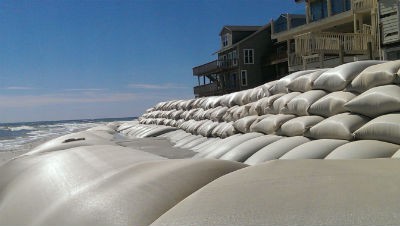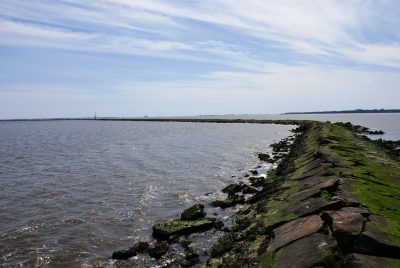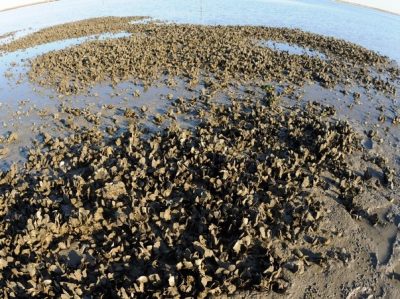RALEIGH — The state Senate gave final approval yesterday to a $21.7 billion state budget that includes dozens of provisions affecting coastal policy and spending, including a weakening of sandbag rules on the beach and raising the cap on small jetties called terminal groins.
Other provisions of the budget continue the restructuring of the state’s major environmental agency, end funding for the cleanup of leaking underground storage tanks on residential property, waive some pollution penalties and kill tax credits for renewable energy projects.
Supporter Spotlight
About the only environmental bright spots in the budget are provisions that increase funding for the state’s natural heritage trust funds and encourage oyster-restoration projects.
The nearly 500-page bill, which arrived 76 days after the end of the fiscal year, was finalized last weekend and released to the public Monday night.
The House is scheduled to begin debate on the bill at 5 p.m. today and potentially hold a final vote to adopt it sometime after midnight.
Several coastal provisions were seen in previous bills this session as well as in the House and Senate versions of the budget.
Sandbag Rules

Among them is a controversial change to sandbag rules. The provisions require the state Coastal Resources Commission to revise rules for sandbag walls on the beach to allow for protection of adjacent properties without a permit. The provision also loosens requirements that the barriers be installed only to protect a structure.
Supporter Spotlight
When the changes to the rules were introduced earlier in the session, opponents said the move could lead to nearly unlimited construction of sandbag walls.
The budget also includes a handful of provisions likely to require federal cooperation as well as approval.
More Terminal Groins
As expected, the budget changes state law to allow for construction of two more terminal groins, raising the total number of projects to six.
Unlike the law the legislature passed in 2011 to lift the ban on terminal groins on the beach, the new provision would restrict the construction of the new groins to New River Inlet, protecting properties on North Topsail Island, and to Bogue Inlet, two locations that had previously decided against projects.
North Topsail officials decided in 2012 to suspend their push for a groin and Carteret County officials ruled out the idea of a terminal groin for Bogue Inlet in 2014. Both cited the expense of building the projects and then maintaining it as the chief reasons.
Rep. Pat McElraft, R-Carteret, said chief Senate budget writer Harry Brown, R-Onslow, whose district includes one side of Bogue Inlet inlet suggested the idea. “He felt we might need one,” she told Coastal Review Online yesterday.
McElraft said should a terminal groin for Bogue prove unnecessary, another community would be able to claim the spot.
The bill also mandates that the N.C. Division of Coastal Resources conduct a beach erosion study to “develop a proposed strategy for preventing, mitigating, and remediating the effects of beach erosion.” The agency is required to complete the study by Feb. 15 and present it to the legislature’s Environmental Review Commission and to the House and Senate environment and natural resources committees.
Land Swaps

The budget plan also continues a call for two key land swaps with federal agencies aimed at improving navigation at Oregon and Beaufort inlets.
Two years ago, the state budget included an extensive provision to allow the state to trade land with the National Park Service and the Interior Department to take over maintenance of Oregon Inlet in Dare County. New language in this year’s budget reinforces that idea and puts up $3 million to sweeten any potential deal. The land on either side of the inlet is part of a national park or a national wildlife refuge
The state is also contemplating a land swap for the western end of Shackleford Banks, which is in Cape Lookout National Seashore, in order to build a groin or jetty there to prevent shoaling in Beaufort Inlet. Shoaling of the inlet, which is entrance to state port in Morehead City, has affected port business and prompted concern over future federal funding of dredge projects there. The move is part of a larger plan to invest in infrastructure at the port as well as improve land and sea access.
Another section of the budget that could require a land swap with federal agencies — albeit a much smaller one — is a provision championed by Sen. Michael Lee, R-New Hanover, calling for a study on removing “The Rocks” at Zeke’s Island, a barrier on the Cape Fear River near Southport that was built in 1871 to stop shoaling in the shipping channel that serves the state port in Wilmington.
“The Cape Fear Estuarine Resource Restoration” section of the bill deems the southern portion of the New Inlet Dam — called “The Rocks” — “an impediment to the natural flow” of water between the Cape Fear River and the Atlantic Ocean. The section extends southwestward from Zeke’s Island and separates New Inlet from the main channel of the Cape Fear River. The provision says it’s necessary to consider removing the section to re-establish that natural flow and directs the N.C. Department of Environment and Natural Resources, or DENR, to notify the Army Corps of Engineers of the state’s intent to study its removal and seek a firm to analyze the costs and benefits.
DENR is also directed to seek approval from the National Oceanic and Atmospheric Administration to adjust the boundaries of the National Estuarine Research Reserve at Zeke’s Island, which formed as a result of building the dam, in a land swap with the state’s nearby Fort Fisher Recreation Area. DENR would use money from a state dredging fund to pay for the project.
Parks Move, DENR cuts
The budget includes several structural changes in state government with the largest a move originally proposed by Gov. Pat McCrory to put state parks and aquariums under the same roof as the zoo and other attractions. The budget requires that the new Department of Cultural and Natural Resources raise fees for all state parks, aquariums and historic sites “to maximize revenue … to the extent practicable to offset appropriations from the General Assembly.”
In a rare example of environmental largess, the budget gives the state parks system an additional $500,000 over the next two years for its centennial celebration.
The move of parks and other attractions continues a trend to transform DENR into a purely regulatory agency. After the move, which becomes effective this year, the department’s name would change to the Department of Environmental Quality.
Natural Heritage Trust Funds

The Parks and Recreation Trust Fund will receive nearly $39 million over the two years from direct funding and license plate sales.
The Clean Water Management Trust Fund, which would also move to the new department, would also receive close to $39 million over the two years with $1 million of that targeted for military buffers.
The budget also mandates that several funds maintained by the department undergo a “continuation review” — essentially justifying their budget and mission — before receiving continued funding.
A loser in the reshuffling is state’s Natural Heritage Program, a non-regulatory agency that merely tracks the state’s rare animals, plants and habitats. It would see the largest budget cut due to the move, losing about 41 percent of its budget. The drop in funding to $450,000 would mean the loss of about half of the program’s staff.
Other environmental programs seem to be headed to the chopping block next year. The budget directs the new Department of Environmental Quality to present a final report to the General Assembly on programs that help clean up pollution from leaking commercial underground storage tanks and prevent mercury pollution.
Renewable Energy
Legislators also agreed to allow the state Renewable Energy Tax Credit expire and to terminate the noncommercial Leaking Underground Storage Tank Fund, which assist landowners with cleanups.
Abandoned Vessels
A provision to “Clarify Coastal County Authority Over Abandoned Vessels” would repeal and rewrite current statutes to allow coastal counties to prohibit the abandonment of vessels in navigable waters within their jurisdiction.
An abandoned vessel would be defined as one that is moored, anchored or otherwise located for more than 30 consecutive days in any 180-day period without permission of the dock owner, or a vessel that is in danger of sinking, has sunk, is resting on the bottom or is located such that it is a hazard to navigation or an immediate danger to other vessels. The action wouldn’t apply to shipwrecks and underwater archeological remains that have been in place for more than 10 years.
The language was inserted by Sen. Bill Cook, R-Beaufort, following a discussion between one of his aides and officials with the East Carolina Council of Governments in New Bern. The council recently conducted a survey to assess the extent of the problem. Council Director Judy Hills told Coastal Review Online there was “no harm” in the budget provision, but more needs to be done on the matter.
“In October we are convening a work group to look more closely at the issue,” Hills said.
Waiving Pollution Penalties
One provision in the budget would lessen penalties for violations of the state’s sediment and erosion control law. Opponents say the change undercuts protections against permanent damage to streams and rivers. Civil penalties could be capped at $25,000 or waived entirely if there are no prior violations and the violator takes action to stop the damage within 180 days of being notified of a violation.
Shellfish Provisions

The budget includes several items related to shellfish, including a ban on the use of oyster shells as a ground cover in commercial landscaping. The state Marine Fisheries Commission would handle enforcement.
The budget also includes new language establishing a marine shellfish sanctuary in Pamlico Sound to be named in honor of late Sen. Jean Preston, a Republican from Carteret County. The sanctuary is intended to enhance shellfish habitats to benefit fisheries, water quality and the economy. The N.C. Division of Marine Fisheries is to designate an area as a recommendation to the Environmental Review Commission for a sanctuary or network of sanctuaries and create a plan for managing it and creating additional oyster habitats.
Also, the division, in consultation with representatives of the commercial fishing industry, representatives of the shellfish aquaculture industry and relevant federal agencies, is directed to create a proposal to open shellfish cultivation leasing areas in Core Sound that are currently subject to a moratorium on shellfish leasing. The resulting report on the plan is to be submitted by April 1, to the Joint Legislative Commission on Governmental Operations.
The budget also includes changes to the shellfish-cultivation leasing program, substituting global positioning system or GPS data for the currently required survey to define leasing area boundaries and increasing the lease terms from five to 10 years.
Permitting for oyster restoration projects are to be simplified under the budget plan. The Division of Marine Fisheries and Division of Coastal Management, along with representatives of conservation organizations working on oyster restoration, would create a new permitting process specifically designed for oyster restoration projects. The report, including recommended legislation, would be due to the Environmental Review Commission no later than May 1.
Mark Hibbs, Coastal Review Online assistant editor, contributed to this report







